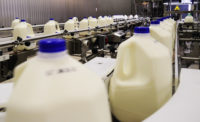A review of the recalls in the last year indicates that allergens are still a significant threat to food safety and one of the most common reason for recalls. A major contributor to these cases of undeclared recalls is not the industry’s lack of understanding of what constitutes a food allergen, but rather error in the processing or packaging of the foods.
Most facilities have developed a robust allergen program as required by FDA, USDA and the Global Food Safety Initiative, but it is the failure to execute those programs that contributes to undeclared allergens in the finished product.
In dairy operations, allergen management would be simple if we were to just bottle fluid milk, but most dairies produce a multitude of products — for example, juices, yogurts, sour cream and dips, to name a few. And if you operate one of those facilities producing ice creams or frozen desserts, we feel your pain.
So, what are some of the causes of allergen-related threats? They include:
-
Improper changeover of products. Most facilities have put together robust cleaning procedures and scheduling formats to guide production and sanitation employees. A matrix informs both scheduling and sanitation personnel of what products can be safely run after other products and where a push with new product, rinses or full washes must be instituted prior to the next product. It is understood that rinsing will not remove allergens and should be used only to flush out the conflicting colors or flavors of the preceding product.
-
Failure to follow validated cleaning procedures. Improper cleaning can result in residual allergenic protein left on equipment and contamination of subsequent product. Cleaning procedures must be validated for the removal of protein. Proper cleaning must be conducted following the production or packaging of allergenic products. Cleaning must be verified upon completion. Verification, at a minimum, is performed visually, but verification using swabbing or ATP is more common and encouraged. This includes transfer utensils, as well as tanks, processing equipment, fillers and pipelines.
-
Errors made in formulating the product. Formulations must be followed using the approved ingredients for the product. A system of verifying that the correct ingredients are used must be established. Chocolate-covered peanuts inadvertently added to ice cream in place of chocolate-covered almonds can trigger a Class 1 Recall.
-
Lack of awareness of allergens in ingredients. There is a trust between ingredient suppliers and processing facilities that allergens are properly identified in ingredients. While this trust is important, it is also important that the ingredient allergen content is verified at the processing plant.
-
Improper labeling. A common cause of recalls, labeling errors, occurs in two forms. First, the allergen is not identified in the product ingredient statement or allergen declaration. This usually results from failure to identify the allergen in the product formulation or inadvertent addition of the allergen in the product through cross-contact or ingredient addition. More common is placing product into the wrong package. This can occur at product changeover or by using the wrong packaging for the product. Verification of packaging material at receipt and when brought to the filler can reduce this threat.
As consumer demand for more and varied products increases the number of allergens in our products and facilities, robust allergen management can make our products safe for all consumers.



